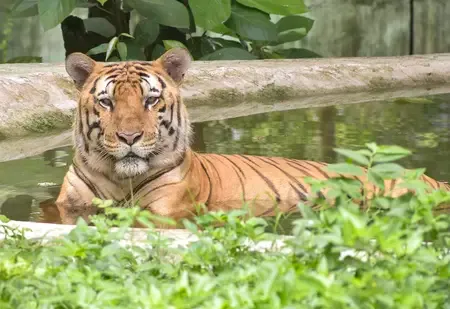How Did TN's Mudumalai Tiger Reserve Achieve a 28% Rise in Feline Population on International Tiger Day?

Synopsis
Key Takeaways
- Mudumalai Tiger Reserve sees a 28% increase in tiger population.
- Community engagement is vital for conservation success.
- Effective habitat restoration plays a crucial role.
- Removal of Lantana camara supports native wildlife.
- Anti-poaching initiatives are essential for protecting big cats.
Chennai, July 29 (NationPress) Celebrating a remarkable milestone on International Tiger Day (July 29), the Mudumalai Tiger Reserve (MTR) has announced a stunning 28% increase in its tiger population for the year 2024–25. The count of tigers has surged from 129 in 2023–24 to 165, bringing joy to both wildlife conservationists and forest officials.
This impressive rise is a result of a mix of dedicated anti-poaching initiatives, successful habitat restoration, and extensive efforts to eliminate invasive plant species.
The MTR, covering an area of 688.59 hectares, includes 321 hectares designated as the core zone and 367.59 hectares classified as the buffer zone.
Within its core zone, nearly 85 swamps significantly contribute to wildlife sustenance by providing vital water resources.
Officials from the Forest Department have raised concerns about the unchecked proliferation of Lantana camara, an invasive shrub that threatens these swamp ecosystems.
"If left unchecked, Lantana would have dominated the swamps, jeopardizing essential habitats," an official noted.
In response to a directive from the Madras High Court, forest teams, with active support from local communities, conducted a large-scale removal of Lantana camara across 725 hectares in four core forest ranges during 2024–25.
The biomass removed was transformed into eco-friendly briquettes by members of the Kattu Naicker, Kurumba, Malasar, and Paniya communities, producing six tonnes thus far, benefiting both conservation efforts and local livelihoods.
A senior MTR official pointed out that eliminating Lantana has allowed sunlight to penetrate the forest floor, promoting the natural regrowth of native grass species. This has, in turn, enhanced prey density, a crucial factor contributing to the rise in tiger numbers.
"Anti-poaching efforts and habitat enhancement are interlinked. An increased prey base directly bolsters predator populations," the official stated. Currently, MTR operates 36 Anti-Poaching Camps (APCs), with plans to establish another in collaboration with tribal communities.
The reserve also supports other important species, including leopards, dholes, hyenas, and vultures, the latter playing a vital role in scavenging and maintaining ecosystem health.
The surge in tiger numbers at Mudumalai is being recognized as a model for conservation throughout the nation.
On this International Tiger Day, the reserve exemplifies the positive impact of continuous, community-driven conservation initiatives.










